What is Kuus file extension
.Kuus file extension is a filename extension that is appended to the name of files affected by the latest version of STOP (djvu) ransomware. Kuus ransomware is a malware that encrypts victims’ files and thus locks up the information contained in them. The ransomware developers demand a ransom in exchange for a decryptor and a key, which are necessary for decrypting the files. Fortunately there is a free decryptor. Kuus File Decrypt Tool is a program that in some cases can help decrypt encrypted files. In addition to this program, there are several other ways to restore the contents of encrypted files.
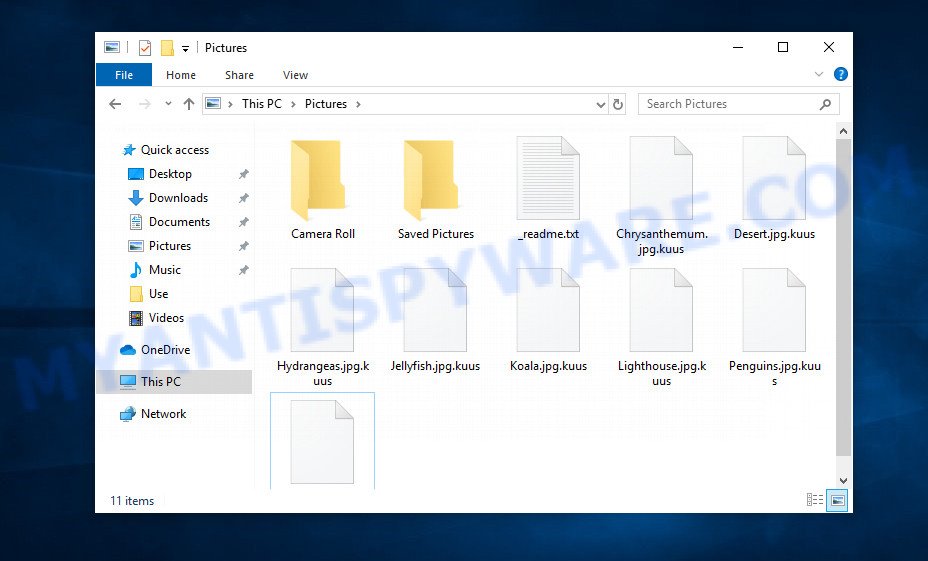
Screenshot of files encrypted by Kuus virus (‘.kuus’ file extension)
What is Kuus ransomware
Kuus ransomware is new malware that is the 241th variant of STOP (DJVU) ransomware. Like other versions of this ransomware, it is distributed through key generators, cracked software, adware and torrents web-sites. Upon execution, Kuus creates a folder in the Windows system directory and copies itself there. Then the virus changes some Windows OS settings so that it starts automatically every time the PC is turned on or restarted.
Kuus ransomware collects information about the victim’s computer, after which it tries to establish a connection with its command-and-control server (C&C). If the connection has been established, the virus receives a key (so called ‘online key’) from the command server that will be used to encrypt files. In addition, Kuus virus may receive additional commands and files that will be executed on the victim’s computer. If Kuus ransomware could not connect to the command server, then it uses a fixed key, which the security researchers called ‘offline key’.
There is a significant difference between ‘online key’ and ‘offline key’. The online key is unique for each victim, that is, the key from one victim will not help decrypt the files of the other victim. The offline key is the same for all victims. Thus, it can be used to decrypt files regardless of where they were encrypted.
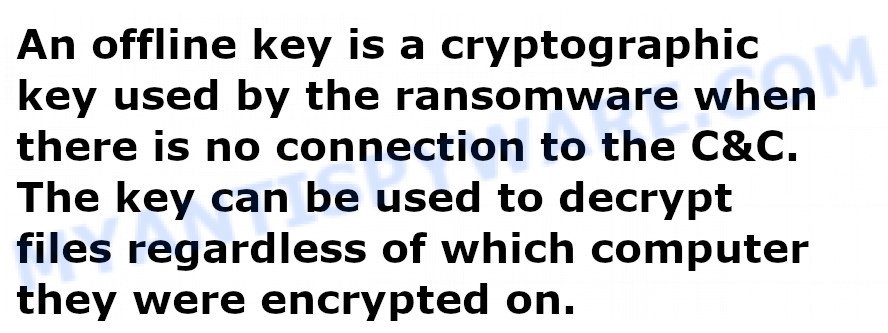
Having a key to encrypt files, Kuus virus proceeds directly to the process of encrypting files. It encrypts file-by-file, so that all files of the victim will be encrypted. It doesn’t matter where the files are located, on the internal drive, flash drive, external media, cloud storage, all of them can be encrypted. There is a small exception, the virus does not encrypt files located in the Windows system directories, files with the extension from the list ‘.lnk, .bat, ini, .sys, .dll’ and files with the name ‘_readme.txt’. Thus, almost all of the victim’s data will be encrypted, including documents, pictures, databases, archives and other types of files, such as:
.big, .xdl, .wire, .iwi, .dxg, .sie, .wsc, .wsh, .wma, .ntl, .bik, .xwp, .flv, .xxx, .t13, .xlsm, .xmind, .sr2, .ws, .pkpass, .qic, .rar, .kdb, .x3f, .wpg, .crt, .odt, .wpw, .pfx, .wcf, .indd, .js, .t12, .0, .wbz, .xlgc, .ncf, .wps, .ai, .sidd, .vtf, .arw, .cas, .wbk, .wp4, .fos, .ff, .xbdoc, .xlsb, .sb, .jpg, .hplg, .xy3, .odp, .xdb, .webdoc, .sav, .raw, .zabw, .wp, .lrf, .yal, .desc, .dazip, .syncdb, .zi, .wmv, .tax, .doc, .x, .ptx, .bc6, .txt, .psd, .hkx, .wgz, .der, .map, .bc7, .xbplate, .wsd, .ibank, .x3f, .cer, .rwl, .blob, .rim, .lvl, .xpm, .ztmp, .yml, .ltx, .py, .xll, .wmo, .vdf, .wot, .menu, .wn, .pptm, .wav, .x3d, .dba, .xlsm, .pdf, .nrw, .forge, .orf, .kdc, .kf, .wp6, .cr2, .wpd, .p12, .webp, .wpt, .mlx, .dmp, .das, .docm, .wbm, .bsa, .w3x, .arch00, .xx, .mov, .jpeg, .hkdb, .3dm, .3fr, .wp5, .ybk, .odc, .odm, .psk, .jpe, .db0, .svg, .xlsx, .xyp, .wbmp, .docx, .m3u, .wdp, .mdb, .zdc, .itdb, .m4a, .asset, .pdd, .xld, .r3d, .xmmap, .rtf, .wdb, .re4, .wbc, .wpe, .wri, .accdb, .fsh, .srf, .1st, .itm, .xlk, .wpd, .srw, .icxs, .gdb, .gho, .avi, .sidn, .cdr, .css, .eps, .wma, .ppt, .layout, .z3d, .epk, .hvpl, .wmf, .esm, .mef, .sql, .pptx, .iwd, .p7c, .sid, .rofl, .zip, .m2, .csv, .dng, .xls, .xar, .png, .mpqge, .cfr, .xlsx, .rb, .zif, wallet, .litemod, .3ds, .qdf, .wpl, .wps, .crw, .pak, .mcmeta, .sis, .dbf, .wmv, .xf, .xml, .7z, .zw, .p7b, .bkf, .erf, .ysp, .zdb, .wotreplay, .vcf, .bar, .mrwref, .xyw, .mp4, .mddata
Each file that has been encrypted by Kuus virus will be renamed. It will append the extension ‘.kuus’ at the end of the name of the affected file. Thus, a file named ‘image.jpg’, after it is encrypted, will receive the name ‘image.jpg.kuus’. To encrypt as many files as possible in the minimum time, the virus does not encrypt the entire file, but only its initial part in the amount of 154 kb. Kuus virus encrypts files sequentially, when all files in the directory are encrypted, it places a new file in it. This file is called ‘_readme.txt’ and its contents are shown below.
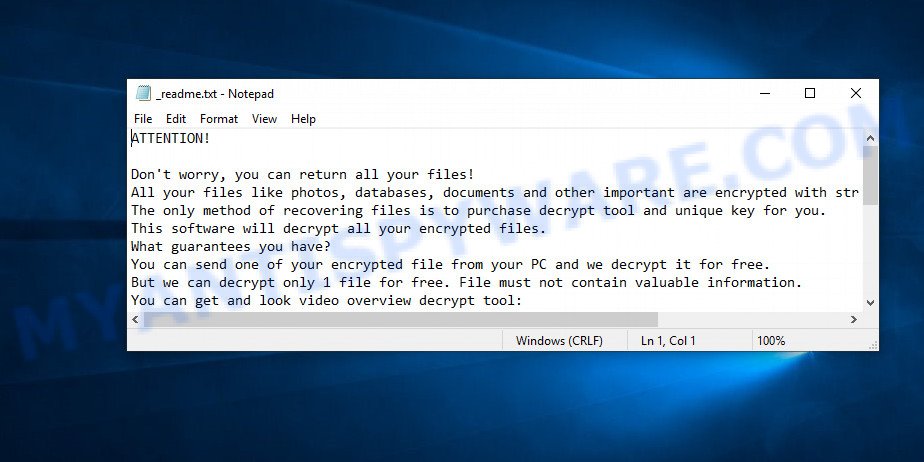
Screenshot of the contents of ‘_readme.txt’ file (ransom note)
This file is a ransom note that is a message from Kuus creators. In this message, the criminals report that the victim’s files are encrypted and there is only one way to decrypt them – purchase the key and the decryptor from them. Attackers set the price for the key and decryptor at $980. If the victim pays the ransom within 72 hours, then Kuus authors agree to make a discount of half the ransom, that is, reduce the size of the ransom to $490. Criminals offer to decrypt one file for free. To do this, the victim needs to send this file to one of the email addresses listed in the ransom demand message. But successful decryption of one file does not guarantee the possibility of decryption of files even after payment of the ransom.
Threat Summary
| Name | Kuus ransomware (Kuus File Virus) |
| Type | Crypto virus, Crypto malware, Filecoder, Ransomware, File locker |
| Encrypted files extension | .kuus |
| Ransom note | _readme.txt |
| Contact | helpmanager@mail.ch, restoremanager@airmail.cc |
| Ransom amount | $490, $980 in Bitcoins |
| Detection Names | Trojan.Win32.Chapak.4!c, Win32:CrypterX-gen [Trj], W32/Trojan.JFLQ-8436, Trojan.TR/AD.InstaBot.ghwos, Win32/Kryptik.HEYU, W32/Ursnif.DA!tr, Ransom:Win32/STOP.BS!MTB, Win32/Trojan.284, BScope.Trojan.Hynamer, Ransom.STOP!8.10810 (CLOUD) |
| Symptoms | Photos, documents and music won’t open. Your photos, documents and music now have new extensions that end with something like .locked, .crypted or .cryptor. Files named such as ‘_readme.txt’, ‘#_README_#’, ‘_DECRYPT_’ or ‘recover’ in each folder with at least one encrypted file.. Ransom note in a pop-up window with cybercriminal’s ransom demand and instructions. |
| Distribution methods | Malicious links in emails. Drive-by downloads from a compromised web page. Social media posts (they can be used to mislead users to download malicious software with a built-in ransomware downloader or click a suspicious link). Torrent webpages. |
| Removal | Kuus ransomware removal guide |
| Decryption | Kuus File Decrypt Tool |
In the ransom note, the Kuus ransomware authors report that it is impossible to decrypt files without a key and a decryptor. In general, this is true; to decrypt .kuus files, you must use the key and the decryptor. This is confirmed by the security researchers. As we reported at the very beginning of this article, there is a free Kuus File Decrypt Tool, which in some cases can decrypt .kuus files. In the case when it could not decrypt the files, there are several more methods, each of which can help the victim restore the files encrypted by Kuus virus. These methods do not require the use of a key and decryptor, and therefore are suitable for all victims.
How to remove Kuus ransomware, Recover, Decrypt .kuus files for free
If you are a victim of ransomware, your files have been encrypted, then we recommend that you follow the simple steps described above. These steps will help you remove Kuus ransomware virus, and decrypt .kuus files. Moreover, we will also demonstrate you how to recover encrypted files if the decryption of the files was unsuccessful. Read the entire manual carefully. To make it easier for you to follow the instructions, we recommend that you print it or open it on your smartphone.
- How to remove Kuus ransomware
- How to decrypt .kuus files
- How to restore .kuus files
- How to protect your machine from Kuus ransomware
How to remove Kuus ransomware
Before you start decrypting or recovering .kuus files, you need to remove the Kuus autostart entries. This must be done since otherwise the ransomware may re-encrypt the restored files. You can stop the ransomware from working, as it is not difficult to do. Another option is to perform a full system scan using free malware removal tools capable of detecting and removing ransomware infection.
It is very important to scan the computer for malware, as security researchers found that spyware could be installed on the infected computer along with the Kuus ransomware. Spyware is a very dangerous security threat as it is designed to steal the user’s personal information such as passwords, logins, contact details, etc. If you have any difficulty removing the Kuus virus, then let us know in the comments, we will try to help you.
To remove Kuus ransomware, follow the steps below:
- Kill the Kuus ransomware process
- Disable the Kuus ransomware Start-Up
- Delete the Kuus ransomware Task
- Scan computer for malware
Kill the Kuus ransomware process
Press CTRL, ALT, DEL keys together.
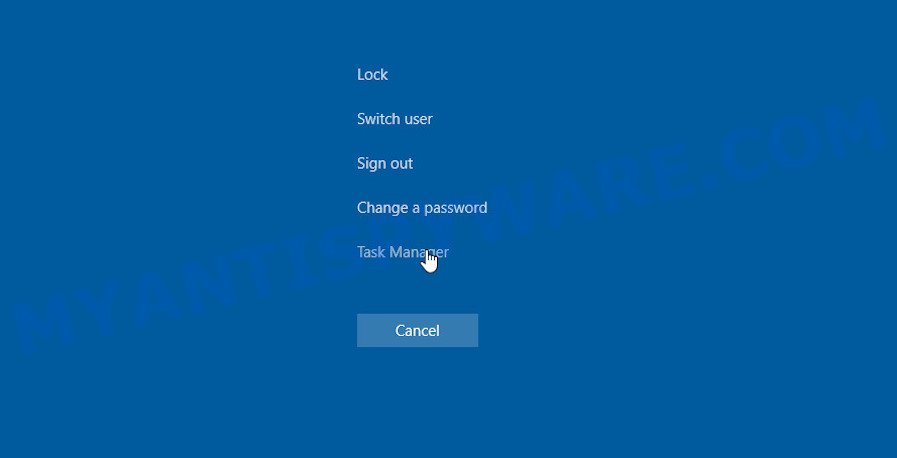
Click Task Manager. Select the “Processes” tab, look for something suspicious that is the Kuus ransomware then right-click it and select “End Task” or “End Process” option. If your Task Manager does not open or the Windows reports “Task manager has been disabled by your administrator”, then follow the guide: How to Fix Task manager has been disabled by your administrator.
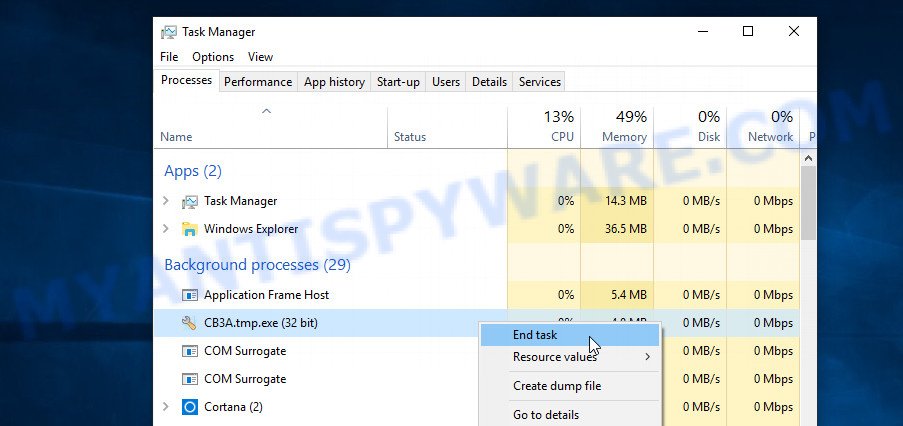
A process is particularly suspicious: it is taking up a lot of memory (despite the fact that you closed all of your programs, its name is not familiar to you (if you are in doubt, you can always check the program by doing a search for its name in Google, Yahoo or Bing).
Disable the Kuus ransomware Start-Up
Select the “Start-Up” tab, look for something similar to the one shown in the example below, right click to it and select Disable.
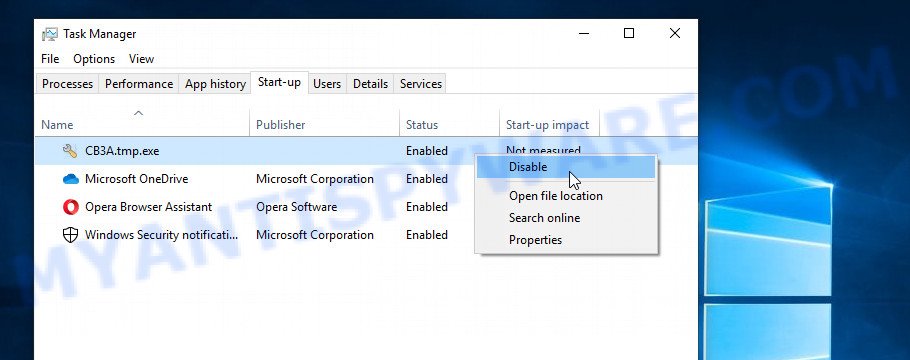
Close Task Manager.
Delete the Kuus ransomware Task
Type “Task Scheduler” in the search bar. Click Task Scheduler app in the search results. Click “Task Scheduler Library” in the left panel. On the right panel, right-click to “Time Trigger Task” and select Delete.
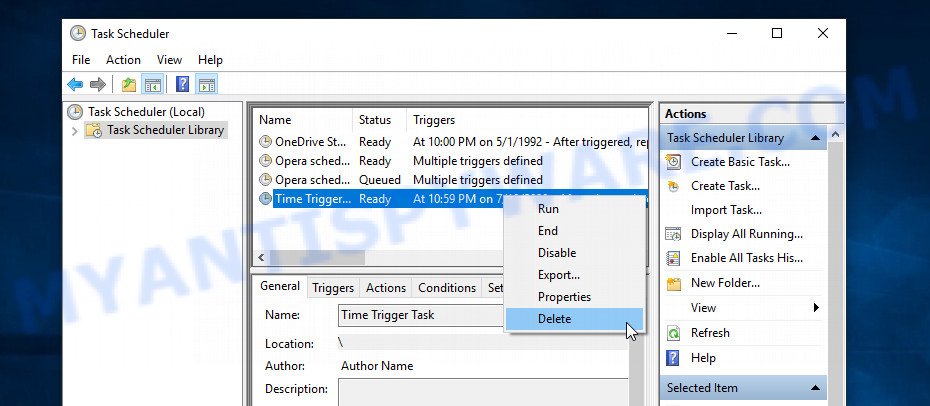
Close Task Scheduler.
Scan computer for malware
Zemana AntiMalware (ZAM) can look for all kinds of malicious software, including ransomware, as well as a variety of Trojans, viruses and rootkits. After the detection of the Kuus ransomware virus, you can easily and quickly uninstall it.
Installing the Zemana Free is simple. First you’ll need to download Zemana AntiMalware by clicking on the following link.
165508 downloads
Author: Zemana Ltd
Category: Security tools
Update: July 16, 2019
After the downloading process is complete, close all windows on your computer. Further, run the install file named Zemana.AntiMalware.Setup. If the “User Account Control” prompt pops up as on the image below, press the “Yes” button.
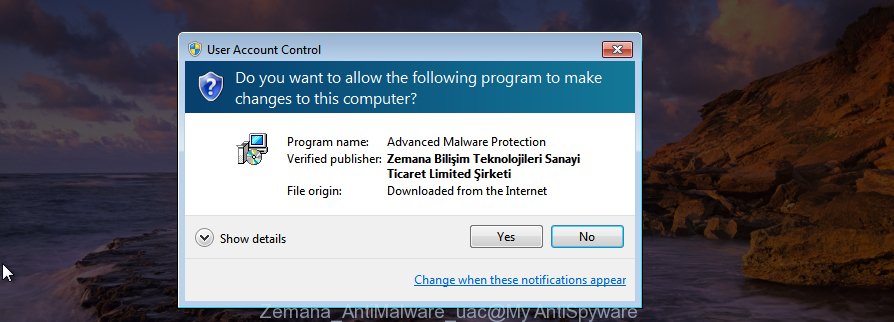
It will display the “Setup wizard” which will assist you install Zemana Anti Malware (ZAM) on the machine. Follow the prompts and do not make any changes to default settings.

Once installation is finished successfully, Zemana will automatically run and you can see its main window as displayed on the image below.

Next, click the “Scan” button . Zemana AntiMalware (ZAM) application will scan through the whole personal computer for the Kuus crypto virus, other malware, worms and trojans.

As the scanning ends, it will show the Scan Results. Once you have selected what you wish to remove from your machine press “Next” button.

The Zemana will uninstall Kuus crypto malware and other security threats. After finished, you can be prompted to restart your PC.
In order to be 100% sure that the computer no longer has the Kuus ransomware virus, we recommend using Kaspersky virus removal tool (KVRT). It is free and easy to use. It may scan and remove ransomware, spyware, PUPs, worms, trojans, adware and other malware. KVRT is powerful enough to find and remove malicious registry entries and files that are hidden on the PC.
Download Kaspersky virus removal tool (KVRT) from the link below. Save it to your Desktop so that you can access the file easily.
129497 downloads
Author: Kaspersky® lab
Category: Security tools
Update: March 5, 2018
After the downloading process is done, double-click on the Kaspersky virus removal tool icon. Once initialization procedure is finished, you will see the Kaspersky virus removal tool screen similar to the one below.

Click Change Parameters and set a check near all your drives. Click OK to close the Parameters window. Next press Start scan button to begin checking your PC system for the Kuus crypto virus and other malicious software. This process can take quite a while, so please be patient.

Once the scan is finished, KVRT will open a list of found items like below.

Make sure all items have ‘checkmark’ and click on Continue to begin a cleaning task.
How to decrypt .kuus files
To decrypt .kuus files, you need to use a unique key and decryptor. Security researchers confirm that it is impossible to access the contents of encrypted files without decryption. Renaming the affected files, changing their extension cannot help the victim, the files will still remain encrypted. Fortunately, there is a free Kuus File Decrypt Tool called STOP Djvu decryptor. In some cases, it can help decrypt .kuus files.
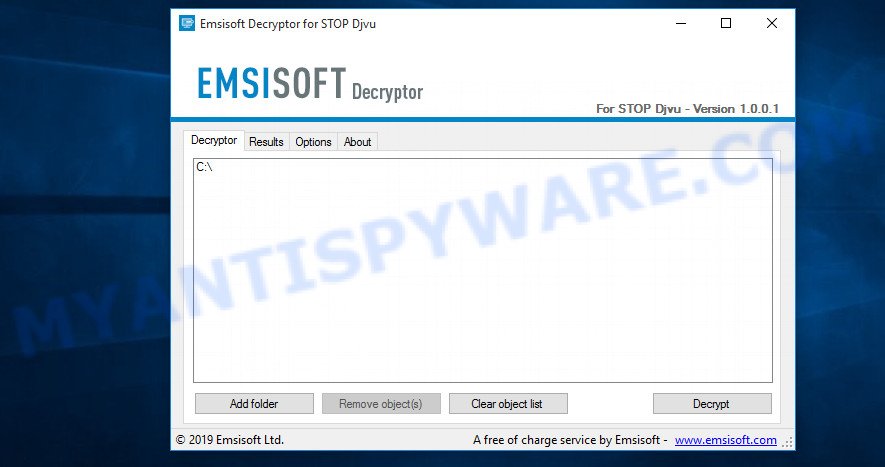
Free Kuus File Decrypt Tool (STOP Djvu decryptor)
To decrypt .kuus files, use Kuus File Decrypt Tool
- Download Kuus File Decrypt Tool from the following link.
STOP Djvu decryptor - Scroll down to ‘New Djvu ransomware’ section.
- Click the download link and save the decrypt_STOPDjvu.exe file to your desktop.
- Run decrypt_STOPDjvu.exe, read the license terms and instructions.
- On the ‘Decryptor’ tab, using the ‘Add a folder’ button, add the directory or disk where the encrypted files are located.
- Click the ‘Decrypt’ button.
Kuus File Decrypt Tool is a free software that can decrypt files only in some cases, when the files were encrypted with an ‘offline key’. If the files were encrypted with an ‘online key’, then they cannot be decrypted. The reason for this is that the decryption key is in the hands of criminals and this key can not be determined. But even in this case, there is a chance to restore the contents of encrypted files, we will talk about this in section “How to restore .kuus files” of this article.
This video step-by-step guide will demonstrate How to remove Kuus ransomware and Decrypt/Recover .kuus files.
How to find out which key was used to encrypt files
Since Kuus Decrypt Tool only decrypts files encrypted with the offline key, each Kuus’s victim needs to find out which key was used to encrypt the files. Determining the type of key used is not difficult. Below we give two ways. Use any of them.
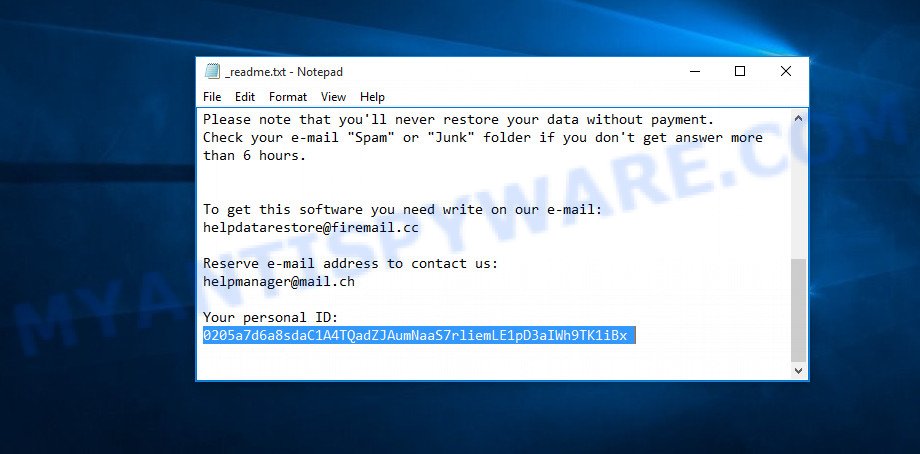
Personal ID is highlighted here
Find out the type of key using ‘_readme.txt’ file
- Open the ransom demand message (‘_readme.txt’ file).
- Scroll down to the end of the file.
- There you will see a line with the text ‘Your personal ID’.
- Below is a line of characters that starts with ‘0241’ – this is your personal id.
Find out the type of key using ‘PersonalID.txt’ file
- Open disk C.
- Open directory ‘SystemID’.
- Open file named ‘PersonalID.txt’. This file lists ‘Personal ID’s that match the keys that the virus used to encrypt files.
The ‘Personal ID’ is not a key, it is an identifier related to a key that was used to encrypt files. If the ID ends with ‘t1’, then the files are encrypted with an offline key. If the ID does not end with ‘t1’, Kuus virus used an online key. If you could not figure out how to determine which key was used to encrypt files, then we can help. Just write a request here or in the comments below.
Kuus File Decrypt Tool : “No key for New Variant online ID”
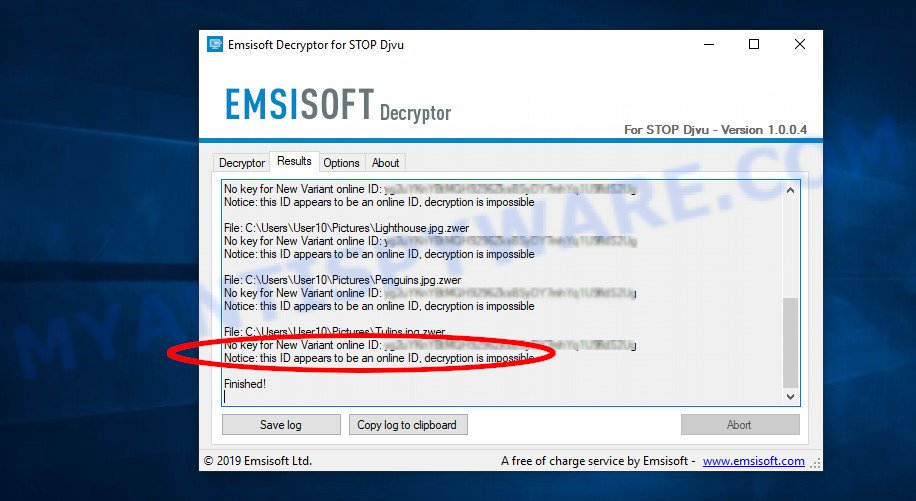
If, when you try to decrypt .kuus files, Kuus File Decrypt Tool reports:
No key for New Variant online ID: *
Notice: this ID appears to be an online ID, decryption is impossible
It means that your files are encrypted with an ‘online key’ and their decryption is impossible, since only the Kuus authors have the key necessary for decryption. In this case, you need to use alternative methods listed below to restore the contents of encrypted files.
Kuus File Decrypt Tool : “No key for New Variant offline ID”
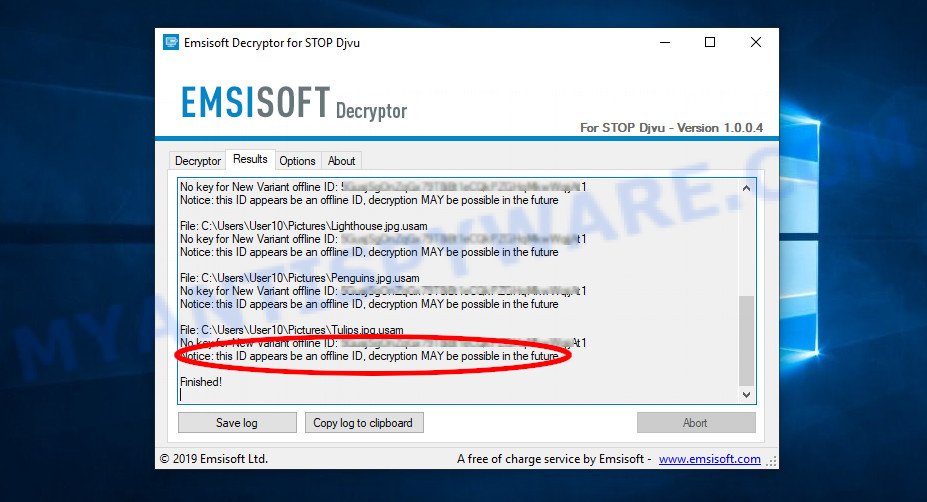
If, during decryption of .kuus files, Kuus File Decrypt Tool reports:
No key for New Variant offline ID: *t1
Notice: this ID appears be an offline ID, decryption MAY be possible in the future.
It means the following: your files are encrypted with an ‘offline key’, but the key itself has not yet been obtained by security researchers, in this case, you need to be patient and wait a while, in addition, you can also use alternative ways for recovering encrypted data.
If for some reason you were unable to decrypt the encrypted files, then We recommend to follow the news on our Facebook or YouTube channels. So you ‘ll know right away that it ‘s possible to decrypt .kuus files.
How to restore .kuus files
If Kuus File Decrypt Tool did not help you, or your files are encrypted using an online key, then there is no need to panic! There are several other alternative methods that may allow you to restore the contents of encrypted files. Once again, remember to be sure to scan your computer for ransomware and malware using free malware removal tools. You must be sure that Kuus ransomware is completely removed.
Restore .kuus files with ShadowExplorer
First of all, try to recover .kuus files from Shadow Volume Copies, which are automatically created by Windows OS. In order to recover photos, documents and music encrypted by Kuus ransomware from Shadow Volume Copies you can use a tool called ShadowExplorer. We recommend using this free utility because it is small in size, has a simple interface and does not require installation on a computer. Unfortunately, ransomware often removes all Shadow copies. Therefore, if Shadow Explorer cannot help you, then immediately proceed to the second method, which is given below.
Visit the page linked below to download ShadowExplorer. Save it to your Desktop.
440041 downloads
Author: ShadowExplorer.com
Category: Security tools
Update: September 15, 2019
After the download is finished, extract the saved file to a folder on your computer. This will create the necessary files like the one below.

Launch the ShadowExplorerPortable application. Now choose the date (2) that you wish to restore from and the drive (1) you wish to recover files (folders) from like below.

On right panel navigate to the file (folder) you wish to restore. Right-click to the file or folder and click the Export button as shown in the following example.

And finally, specify a directory (your Desktop) to save the shadow copy of encrypted file and press ‘OK’ button.
This video step-by-step guide will demonstrate How to recover encrypted files using Shadow Explorer.
Restore .kuus files with PhotoRec
Another alternative way to recover .kuus files is to use data recovery software. This method requires a lot of time, but in most cases it allows you to recover part, and sometimes all, encrypted files. To restore .kuus files, use a free tool called Photo Rec. It has a simple interface and does not require installation.
Download PhotoRec from the following link. Save it to your Desktop.
Once the downloading process is done, open a directory in which you saved it. Right click to testdisk-7.0.win and choose Extract all. Follow the prompts. Next please open the testdisk-7.0 folder like below.

Double click on qphotorec_win to run PhotoRec for Windows. It’ll display a screen like below.

Select a drive to recover as shown on the image below.

You will see a list of available partitions. Choose a partition that holds encrypted files as displayed below.

Click File Formats button and select file types to restore. You can to enable or disable the recovery of certain file types. When this is finished, press OK button.

Next, click Browse button to select where recovered photos, documents and music should be written, then click Search. We strongly recommend that you use an external device to save the restored files!

Count of restored files is updated in real time. All restored photos, documents and music are written in a folder that you have selected on the previous step. You can to access the files even if the restore process is not finished.
When the recovery is done, click on Quit button. Next, open the directory where recovered photos, documents and music are stored. You will see a contents like below.

All restored personal files are written in recup_dir.1, recup_dir.2 … sub-directories. If you’re searching for a specific file, then you can to sort your recovered files by extension and/or date/time.
This video step-by-step guide will demonstrate How to recover encrypted files using PhotoRec.
How to protect your PC from Kuus ransomware
Most antivirus software already have built-in protection system against the crypto virus. Therefore, if your PC does not have an antivirus application, make sure you install it. As an extra protection, run the HitmanPro.Alert. All-in-all, HitmanPro.Alert is a fantastic utility to protect your system from any ransomware. If ransomware is detected, then HitmanPro.Alert automatically neutralizes malware and restores the encrypted files. HitmanPro.Alert is compatible with all versions of Microsoft Windows OS from Windows XP to Windows 10.
HitmanPro Alert can be downloaded from the following link. Save it to your Desktop so that you can access the file easily.
When the downloading process is complete, open the file location. You will see an icon like below.

Double click the HitmanPro Alert desktop icon. Once the tool is started, you will be displayed a window where you can select a level of protection, as displayed in the following example.
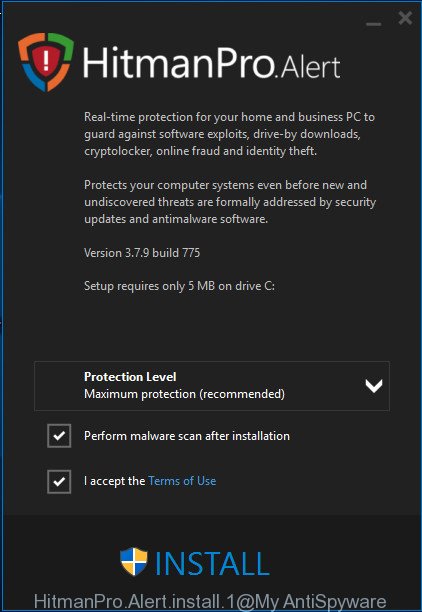
Now click the Install button to activate the protection.
To sum up
This guide was created to help all victims of Kuus ransomware virus. We tried to give answers to the following questions: how to remove ransomware; how to decrypt .kuus files; how to recover files, if the Kuus Decrypt Tool does not help; what is an online key and what is an offline key. We hope that the information presented in this manual has helped you.
If you have questions, then write to us, leaving a comment below. If you need more help with Kuus related issues, go to here.






















txt files still exist: _readme